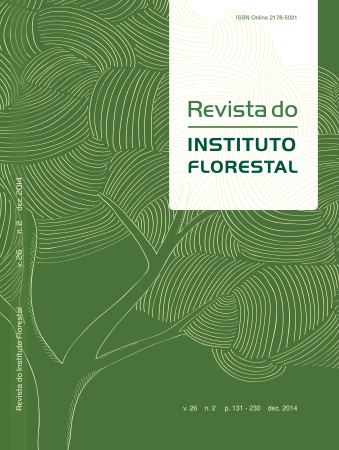SURVIVAL OF Cyathea atrovirens (CYATHEACEAE; PTERIDOPHYTA) AFTER DEFORESTATION
DOI:
https://doi.org/10.4322/rif.2014.017Keywords:
road verge, conservation, relocation, highway, tree fern, transplantAbstract
Adoption of mitigation procedures is necessary to minimize the environmental impact caused by deforestation for construction of roads. In this context, evaluation of the adaptation of plant species that remained on the roadside after deforestation associated with the relocation of the specimens that were withdrawn may promote the preservation of these species. The aim of this study was to evaluate the adaptation of Cyathea atrovirens, that remained on the edge of the runway after deforestation (Experiment-ABE) for construction of the southern section of Mário Covas highway in São Paulo and also to evaluate the possibility of relocation of individuals of this species that were withdrawn during the suppression of the forest (Experiment-AT), until 43 months. The specimens of ABE showed 97% survival and those of AT, 80% survival. New fiddleheads and fronds were observed, as well as the growth of the caudex of both experiments. The results showed that removal and relocation of ferns that remained on the edges of the forest after the removal of vegetation are not necessary and that there was adaptation of the transplanted specimens, representing an important measure for the conservation of C. atrovirens, besides contributing to the deforestation planning for the construction of highways, minimizing environmental impact.
Downloads
References
COELHO, S.J.; CARVALHO, E.M.A.F.; MAIA, L.G.S. Resgate das pteridófitas na área diretamente afetada do Aproveitamento Hidrelétrico do Funil-MG. Revista Brasileira de Biociências, v. 5, p. 489-491, 2007. Supl. 1.
CENTRO DE PREVISÃO DE TEMPO E ESTUDOS CLIMÁTICOS – CPTEC/INSTITUTO NACIONAL DE PESQUISAS ESPACIAIS – INPE. Previsão climática. 2012. Disponível em: . Acesso em: 5 ago. 2014.
CURY, R.T.S. et al. Sobrevivência de plântulas transplantadas de uma floresta tropical madura para viveiro de mudas na bacia do rio Xingu. Revista do Instituto Florestal, v. 25, n. 1, p. 53-63, 2013
ELEUTÉRIO, A.A.; PEREZ-SALICRUP, D. Transplanting tree ferns to promote their conservation in Mexico. American Fern Journal, v. 99, n. 4, p. 279-291, 2009.
FARIAS, R.P.; XAVIER, S.R.S. Fenologia e sobrevivência de três populações de samambaias em remanescentes de Floresta Atlântica Nordestina, Paraíba, Brasil. Biotemas, v. 24, n. 2, p. 13-20, 2011.
FRANZ, I.; SCHMITT, J.L. Blechnum brasiliense Desv. (Pteridophyta, Blechnaceae): estrutura populacional e desenvolvimento da fase esporofítica. Pesquisas: Botânica, v. 56, p. 173-184, 2005.
INÁCIO, C.D.; LEITE, S.L.C. Avaliação de transplantes de árvores em Porto Alegre, Rio Grande do Sul. Iheringia Sér. Botânica, v. 62, n. 1-2, p. 19-29, 2007.
INTERNATIONAL UNION FOR CONSERVATION OF NATURE – IUCN. The IUCN red list of threatened species. 2014. Disponível em: . Acesso em: 15 dez. 2014.
KÖPPEN, W. Climatologia: con un estudio de los climas de la tierra. Mexico: Fondo de Cultura Econômica, 1948. 479 p.
LEHN, C.R.; LEUCHTENBERGER, C. Resistência ao fogo em uma população de Cyathea atrovirens (Langsd. & Fisch) Domin (Cyatheaceae) no Estado do Rio Grande do Sul, Brasil. Biotemas, v. 21, n. 3, p. 15-21, 2008.
NUNES, C.C.S.; SOUZA, D.R. Sobrevivência de quatro espécies lenhosas nativas cultivadas em solos degradados, Cruz das Almas, Bahia. Magistra, v. 23, n. 1-2, p. 11-16, 2011.
O’FARRELL, P.J.; MILTON, S.J. Road verge and rangeland plant communities in the southern Karoo: exploring what influences diversity, dominance and cover. Biodiversity and Conservation, v. 15, p. 921-938, 2006.
PRADO, J. Pteridófitas do Maciço da Juréia. In: DULEBA, W.; MARQUES, O.A.V. (Ed.). Estação Ecológica Juréia-Itatins: ambiente físico, flora e fauna. Ribeirão Preto: Holos, 2004. p. 139-151.
PRIMACK, R.B. A primer of conservation biology. Suderland: Sinauer Associates, 2008. 349 p
SAKAGAMI, C.R. Pteridófitas do Parque Ecológico da Klabin, Telêmaco Borba, Paraná, Brasil. 2006. 200 f. Dissertação (Mestrado em Botânica) – Universidade Federal do Paraná. Curitiba. Disponível em: . Acesso em: 5 ago. 2014.
SCHMITT, J.L.; WINDISCH, P.G. Estrutura populacional e desenvolvimento da fase esporofitica de Cyathea delgadii Sternb. (Cyatheaceae, Monilophyta) no sul do Brasil. Acta Botanica Brasilica, v. 21, n. 3, p. 731-740, 2007.
______. Caudex growth and phenology of Cyathea atrovirens (Langsd. & Fisch.) Domin (Cyatheaceae) in secondary forest, southern Brazil. Braz. J. Biol., v. 72, n. 2, p. 397-405, 2012.
______.; SCHNEIDER, P.H.; WINDISCH, P.G. Crescimento do cáudice e fenologia de Dicksonia sellowiana Hook. (Dicksoniaceae) no sul do Brasil. Acta Botanica Brasilica, v. 23, n. 1, p. 282-291, 2009.
SUGIYAMA, M. Biomas do Estado de São Paulo. In: BONONI, V.L.R (Coord.). Biodiversidade. São Paulo: SMA, 2010. p. 31-49.
VASCONCELOS, P.B.; ARAÚJO, G.M. Comparação da estrutura arbórea de reservas e áreas na beira de estradas de cerrado (sentido restrito) no Triângulo Mineiro. In: BAGER, A. (Ed.). Ecologia de estradas. Lavras: UFLA, 2012. p. 283-296x
















